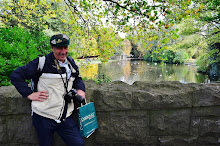THE REALITY OF VENICE
Words and pics by Ian Smith
It's a happening ruin, in transit so to speak. The
crumbling plaster, exposed brickwork, flaking paint, bolts with brackets
holding walls together, buildings at crazy angles, cables hanging from nothing
going nowhere, streets so narrow at times you have to turn sideways to pass by
other couples; the unevenness of the cobbles straining your legs.
It's a nightmare. The population is in decline; people don't want to live there and who can blame them. Modern living has almost bypassed this place.
The gondolier has found a client, a French couple with a pram and a group of Americans quickly follow in the second craft. They both choose the 100 euros cheap ride as distinct from the 150 euros grand tour. I ponder whether or not they accept cheques, my sense of humour not having diminished one iota.
Our window at the restaurant is adorned with African violets and imitation
roses plus purple fake flowers set in crystals. A scallop bottomed red
curtain swings above us caressed by the zephyr that drifts though the window,
its colour matched by the shop across the way selling Ferrari merchandise.
Our waitress is fluent in at least three languages and the couple next to us turn out to be Australian so, for a short time on our trip, language is not a problem. They're from Sydney, an affable pair whose children are being minded by their grandparents. They'd seen an Emirates special on T.V. and taken a punt, picking up a $1,200 airfare. He's a civil engineer and his wife always wanted to come back to Italy, last seen 20 years ago.
Somewhere along the
line we stumbled into the Santa Maria di Nazareth Carmelite church (aka Chiesa
degli Scalzi, church of the barefoot), a late 17th century edifice
rebuilt by the Jesuits and designed by Baldassarre Longhena that once had a
master fresco by Tiepolo in the nave until the Austrians shelled the place in
1915. Ettore Tito repainted that area in
the 1930’s but there is a lesser Tiepolo fresco still on the vault of the
Ruzzini Chapel. The church is the
resting place of the last doge of Venice, Ludovico Manin, who died in 1802.
The most dazzling thing
that catches your eye however is Giuseppe Pozzo’s sacrament tabernacle, encrusted
with lapis lazuli which asserts the re-entry into Venice of the Jesuits.
We have been in Venezia for over 4 hours and still haven't reached the Piazza San Marco, deliberately strolling into courtyards, blind alleys and back streets en route.
We've managed eventually to get to the Ponte de Rialto and its graffiti, the bridge that had to be built in stone because its wooden predecessors had twice collapsed. We noticed the crowd visibly thicken so we stayed with the crush, the number of shops also increasing to the point where that's all there is, until, suddenly, we're there.
Some hyped places are a bit of a let-down. All the pre publicity drains the excitement of seeing a major attraction for the first time. Not so here, its magnificence is overwhelming, its manner grand, its opulence dazzling.
I'm fascinated by the church, actually basilica. Layer upon layer of visible history taunts your eyes. Here a Roman mosaic, there some Renaissance work, elsewhere some Romanesque statues shoved into the walls. It's like someone found all these bits of European history and put them all in one place in random order, but that’s what you could do when you were the prime traders in the Mediterranean.
Overall its Byzantine influence is dominant though, with the spectacular wall mosaics and the four bronze horses outside that came from the Hippodrome, in then Constantinople where it all started. They were originally made in Chios, a Greek island that suffered an appalling massacre during the Ottoman takeover.
Another thing of note taken from Constantinople in 1204 on the exterior is
the statue of the Four Tetrarchs. It represents the inter-dependence of the
four Roman rulers who ruled when the empire had been split up under the
co-emperor plan devised by Diocletian. It is set into the southwestern corner
of the basilica.
The 98.6 metre tall Campinale (bell tower) in the middle of the square is a
1912 rebuild after the original collapsed in 1902. I ponder that it must have been something to
see as it all came tumbling down. The
two tall columns are also eye catching, but I wonder just how many people have
ever seen the third. It’s buried in the
silt at the bottom of the nearby canal because they didn’t quite manage to get
it ashore.
Elsewhere Rosemarie is off shopping. We'd checked out paintings earlier but now we're plunging into every glass shop available, and they are numerous. She likes several items but ultimately buys nothing. Many, I have to agree, are stunningly beautiful, their colours flowing through the glass like shattered rainbows and the ones shaped like birds I thought were really special.
We commenced our return journey towards the station after sunset and got lost, heading towards the Arsenale and still without a map before we began asking people directions.
That's when we came to the main route whose cafes and tourist shops are never ending. When we reach the station we duck up a side alley to a shop selling paintings that we had visited earlier.
After some time Rosemarie decides on two and I negotiate a cheaper price just before the shop closes, satisfied that for at least once in Venice we didn't get ripped off.
The only downer for the day was that my camera isn't working and our current landlord offered us his for which I was grateful.
I still take picture, many picture.....













0 Comments:
Post a Comment
<< Home